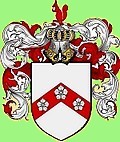 THE GILBERT FAMILY HISTORY
THE GILBERT FAMILY HISTORY
E Morris & Son, Ironfounders of Lewes and Eastbourne
Website created by Richard Gilbert, last updated 12 August 2022.
MAIN NAVIGATION MAP
GILBERT; Waldron 1700s & earlier
|
HASSELL; Waldron --
GILBERT; Waldron 1800s --
GILBERT; to the USA
|
SODDY; Sussex & London --
GILBERT; Eastbourne 1800s --
MORRIS; Lewes & Eastbourne
|
HEWITT & HEDGEGOTT --
GILBERT; Eastbourne 1900 onwards --
CLEMENTSON; London
|
GILBERT; in the USA
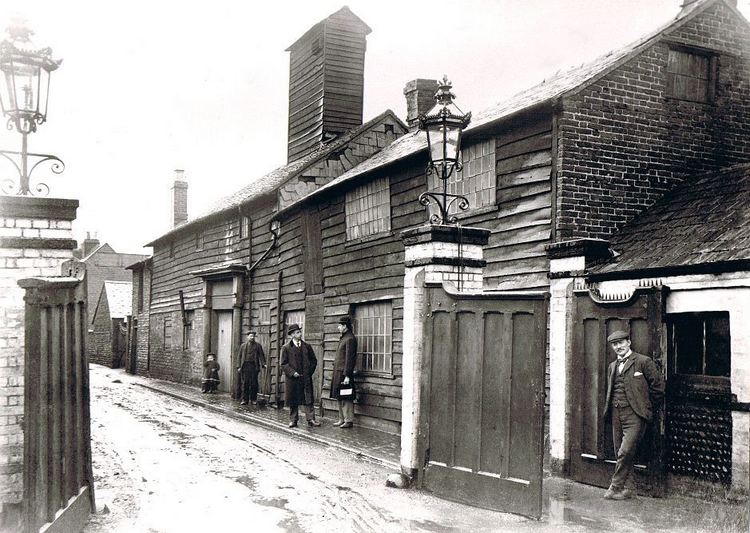
The Morris iron foundry in Lewes. In the centre, apparently speaking to each other are Frank (1869-1913) and Robert (1865-1948), sons of
James Berry Morris but not partners in the firm.
The view would seem to be taken from just inside the Lewes Gas Company premises looking down Foundry Lane towards Cliffe High Street.
Photographer Frederick A Bourne, Eastbourne, 16 November 1900.
Ebenezer Morris (1801-1888) established an ironfoundry business in Foundry Lane, Lewes, East Sussex in 1822. An ironmonger's shop and house at 41/42 Cliffe High Street was added, and a branch was later opened in Eastbourne, comprising a shop and a smaller works. The business survived until 15 July 1890.
 More information about Ebenezer Morris and his family.
More information about Ebenezer Morris and his family.
Much of the information on this page was researched by Richard Gilbert (1894-1988), particularly that recorded in his booklet "E Morris & Son - Partners in Eastbourne's Development" (1974).

IRON FOUNDRY, SHOP AND HOUSE, LEWES
Nicholas Polhill bought some land south of Cliffe High Street in Lewes in 1784 and, about two years later, built an iron foundry and workshop there, said to have been the only one in Sussex at the time and for forty years thereafter. The buildings stood on the eastern side of the road afterwards known as Foundry Lane. This foundry relied almost entirely on scrap metal, in contrast to the old Sussex Wealden ironworks which used locally-mined ore and were, by this time, virtually extinct.
In 1811 Polhill died and the business was taken over by James Sturt (with partner Thomas Gibson) until he also died in 1822. when it was acquired by Ebenezer Morris (1801-1888). Ebenezer was only 20 and had intended to be a farmer but, on the advice of his father, put the business in the hands of trustees and went off to gain experience of the ironmongery trade with a firm in Newgate Street, London.
He returned to Lewes in 1823 and established the business, including an ironmongers shop on the south side of Cliffe High Street. The shop was described as "low-pitched with an overhanging upper storey". Outside, suspended from a wrought iron bracket projecting from the eaves of the wooden building, was a large copper kettle destined to become the firm's trademark for more than a century. It was apparently made by a coppersmith named Lomas, employed at the foundry in Polhill's time.
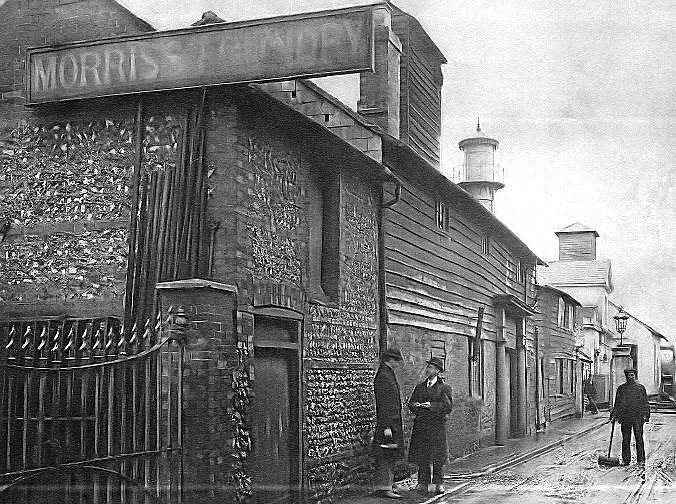
The Morris works in Foundry Lane, looking from Cliffe High Street towards the Lewes Gas Company premises.
Photograph by Frederick A Bourne, Eastbourne, 16 November 1900.
Trade was prosperous and this resulted in the demolition of the shop and the erection of a new one, completed in November 1830. A launch party was held, attended by 30 guests and 90 employees who enjoyed the contents of the copper kettle - a bushel (8 gallons) of punch! Incidentally, when the kettle was taken down for regilding some 20 years later it was found to be full of rainwater. The kettle weighed 28 lbs and the water would have added a further 80 lbs, making a total of around a hundredweight (50 kgs). This would have constituted a potential danger to pedestrians walking underneath so, as a precaution, a hole was drilled in the bottom!
All Ebenezer's 13 children were born in the Cliffe High Street premises. East Sussex Record Office AMS 5569/14 is a plan of the garden at the rear of 41 & 42 Cliffe High Street around 1863, showing the position of pear trees with dates of planting (1858-1862) and varieties.
The cast iron entrance arch at Lewes's Jireh Chapel in Malling Street was made by E Morris & Son.
By the mid 19th century a great business opportunity arose when the Earl of Burlingham set about the development of Eastbourne, and Ebenezer Morris was quick to take advantage of this by setting up a branch in the town. The fact that the Earl's surveyor was James Berry, Ebenezer's brother-in-law, was no doubt an advantage! Large contracts for cast iron work of all descriptions were secured, so much so that one wonders how the Lewes foundry was able to cope with them.
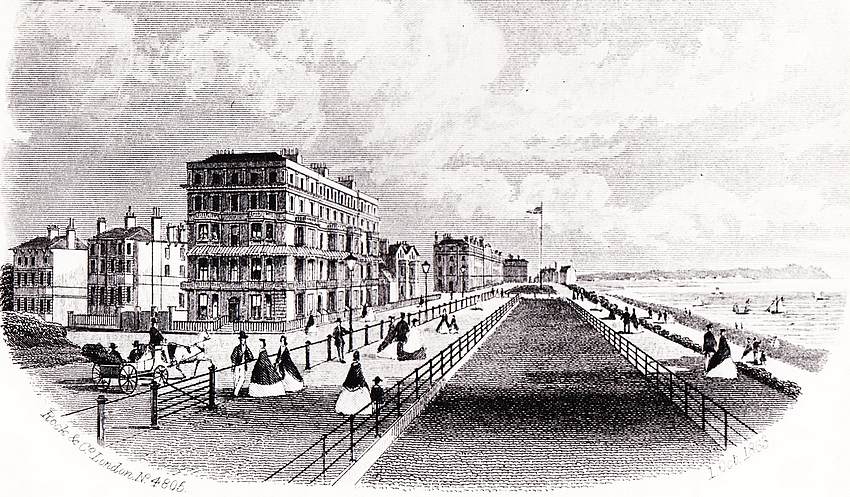
Proving that business was brisk in Eastbourne, all the railings and lampposts in this picture were made by E Morris & Son in Lewes. The engraving (by Rock & Co, London and dated 1 October 1863) shows the eastern end of Eastbourne's Grand Parade with Trinity Place in the left foreground and the old "Field House" (approximately the position of the present pier) to the right of the flagpole. No fencing has yet been erected around the Carpet Gardens (surrounding the flagpole), but the gas lamp standards set into the railing posts beside the road are typically Morris. The strip of grass shown in the centre of the picture on the middle parade was removed around 1900.
On Eastbourne seafront there still remains a long line of heavy Morris railings, separating the middle and upper parades, from opposite the Wish Tower almost to the Carpet Gardens. They continue from the pier to the Redoubt, and more can be found at South Cliff and Trinity Trees. Many of these bear the Morris name and were probably erected around 1860. The top rail and heavy hexagonal posts (of which there are about seventy, probably dating from around 1870) on the road side of the Carpet Gardens are also Morris products, and the caps or fillets of several of these are also marked Morris. There were originally many more Morris posts and rails along the seafront, but a large number were removed, probably during World War II and possibly melted down for the war effort.
Railings of a different type run along the seaward side of the middle parade (other than around the bandstand), of an ornamental character with a single square-section rail twisted spirally in the centre, and often supported by two-branched stanchions. The main posts all bear the Morris names but, due to the many coats of paint applied over the years, some are hard to read; however some seem to say "Morris Lewes" while others could be "Morris Eastbourne".
It is also said that Morris supplied balcony and area railings for many of the hotels and boarding houses, in particular the Queens Hotel; and the gates and rails in front of Cavendish Place Chapel, the rails outside the High Street entrance to the Manor Gardens (opposite Moatcroft Road), and basement railings in the older parts of town all appear to be of the same pattern as the gates of the North Street workshop shown in the picture further down this page. Many Eastbourne gutter terminals and drain grids also bear the firm's name.
Surprisingly there is no evidence that Morris had any activity in Brighton, but they didn't lack enterprise, as evidenced by the fact that Richard Gilbert (1894-1988) found a Morris cast iron bench seat in the grounds of the Crystal Palace in the 1930s. This may have come from Hyde Park in 1852 when the Palace was moved to Sydenham.
E Morris & Son Lewes foundry interior. Photographer Frederick A Bourne, Eastbourne, 16 November 1900.
Ebenezer died on 10 October 1888 after 25 years of prosperity and the business came into the hands of his son James Berry Morris. James seems to have felt that the future lay in Eastbourne rather than Lewes and in October 1889 he appears to have mortgaged the whole property for £1500 to Elizabeth Newington of Lewes. The following year (15 July 1890) the Cliffe shop and house - 41 & 42 High Street - were sold, but the foundry was retained. East Sussex Record Office AMS 5569/15 is a bundle of particulars, plans and conditions of the sale of 41 & 42 Cliffe High Street (house, shop, offices, tinsmith's and coppersmith's works and two cottages in South Court) recorded as the residence of the late Ebenezer Morris. In 1891, the extensive grounds behind the shop were developed, and a new road formed there called Morris Road.
The famous copper kettle was brought from Lewes and hung outside the Eastbourne shop. James progressively started to hand over the running of the business to three of his sons, James (1854-1921), Henry (1863-1943) and Reginald (1862-1909).
From Robert Morris's (Uckfield) diary;
22 December 1899; "J.B.M. abed all day. No doubt influenza." ("J.B.M." was James Berry Morris)
23 December 1899; "To the Foundry, to pay the men &c."
30 December 1899; "To Lewes to pay Foundry men etc." (This seems to be a weekly task for Robert while his father was unwell.)
5 January 1900; "I did the Govr's Xmas bills & sent off about 2 dozen." (The "Govr." also means James Berry Morris)
6 January 1900; "To Lewes this morning to see to the Foundry."
7 July 1900; "E.M.& S's. (E.Morris & Sons.) employees outing, they came to Uckfield. Reg accompanied them & brought with him 2 creepers
for our garden."
20 October 1900; "J.B.M. has given notice at the Foundry of his intention of shortly closing the establishment."
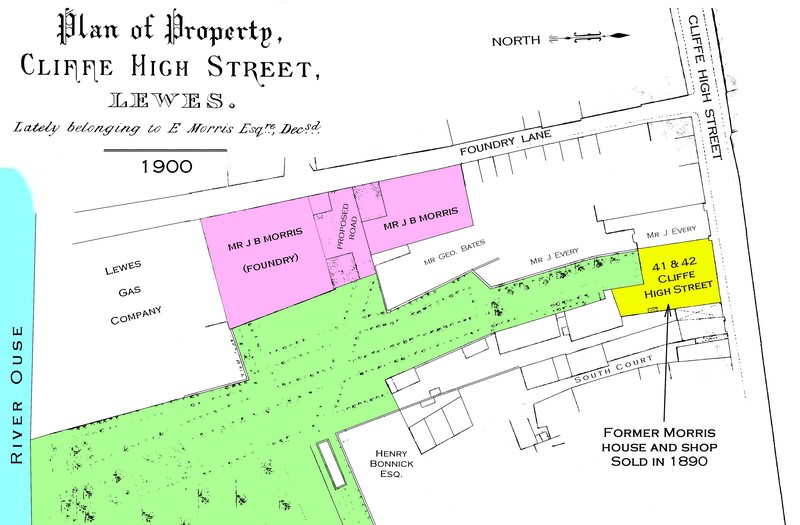
27 October 1900; "J.B.M. has sold the Foundry at Lewes."
13 November 1900; "Called on Mr.F.A.B." (F.A.Bourne, the Eastbourne photographer) "Frank has arranged with him to photograph the Foundry
at Lewes."
16 November 1900; "I, Reg and Frank accompanied Mr.F.A.Bourne to Lewes this morning. He exposed 6 half plates on the Foundry."
1 December 1900; "J.B.M. really severs his connection with the Lewes Foundry today."
21 December 1900; "J.B.M. has quite settled up with the Foundry."
East Sussex Record Office AMS 5569/69/150 is a copy of a circular letter to customers announcing the closure of the Cliffe Foundry (as a result of an accident to Mr.Morris snr.) on 24 November 1900.
Clearly from this point the firm would no longer be able to carry out casting contracts, and would have to sub-contract the work to others. But this change probably made sense for the company as most of the big contracts had been carried out by this time. However the shop in Eastbourne continued to be run as a conventional ironmonger, rather than as a promotional unit in the town for the Lewes foundry, and E.Morris & Son then became entirely based around the premises at 66/67 Seaside Road (as 1/2 Victoria Place had become in 1901).

IRONMONGERS SHOP, HOUSE AND WORKSHOPS, EASTBOURNE
The Eastbourne shop was opened in 1850 in South Street which, in those days, extended only from the junction with Grove Road to Gildredge Road. The premises was one of four properties on the north side of South Street owned by Thomas White. Three of White's properties were described as "House and Gardens" and one as "House and Premises", so it is assumed that the Morris shop was in the latter. This would place it almost exactly where the present Dewdrop Inn was later built (in 1870).
Apparently the property was next door to a house occupied by a watchmaker named William Morris although it is not thought that he was a relative. William was apparently the only auctioneer in the town at the time and, according to James Berry Morris's recollection "A watchmaker, a house agent, and let out cutlery and plated goods to visitors." At the time of the 1841 Census there were two watchmakers named William Morris in South Street, father and son living in the same house. It's not clear which house, but is likely to be the location of the present shops at 33 and 35 South Street, immediately west of the Dewdrop Inn.
The two watchmakers may not have been related to the Lewes Morris family, but there was slight connection, as William's oldest daughter Matilda married Thomas Caffyn in 1841 and their son William Morris Caffyn (born in 1842) was apprenticed to Ebenezer Morris in 1858 (long after the Morris iron business had moved away from South Street) when he would have been 15 or 16. The Caffyn family (known for their local garages) still apparently hold the Indenture document. My thanks to Alan Smith of the Eastbourne Local History Society and Gavin Whippy for much of the historical information above.
Ebenezer's son James Berry Morris (1828-1901) was placed in command of the Eastbourne activity, although he did not initially live there.
 More information about James Berry Morris and his family.
More information about James Berry Morris and his family.
James immediately started looking for something more permanent and, on 6 April 1853, signed an agreement with local chemist James Dexter to purchase for £21 (he had been asking for £30) a plot of land on the western side of what it now the junction of Seaside Road and Elms Avenue. This was to be the site of his new ironmongers shop, numbered 1 Victoria Place at that time, but renumbered in 1901 as 66 Seaside Road. Three iron plates inscribed "E.M. 1853" (cast in Lewes, no doubt) were set into the pavement in Elms Avenue. One of these plates disappeared during the erection of a traffic sign in 1974, and the others also seem to have gone now.
At the same time James Dexter also sold two plots immediately west of the Morris purchase, to an Edward Maynard. Maynard already owned the entire space (then largely undeveloped) between Seaside Road and Terminus Road, and James Berry Morris took the opportunity to buy from him for £41 an area of ground 40 feet x 40 feet in North Street (then called Little North Street), opposite his Seaside Road plot. This would seem to be where Morris later built a yard and workshop, to be known as the "North Street Shops" (workshops) or "The Foundry" although there is no evidence that any casting actually went on there. In later days the area was referred to as "Tinker's Town" by the employees who worked there.
Ebenezer Morris is not shown in the Rate Book for the South Street premises as a tenant after 1854, and this seems to have coincided with the ground floor of 1 Victoria Place being opened as E Morris's Eastbourne ironmongers shop. Plot No.1 which Dexter sold to Morris in 1853 was destined to become the site of the first house of a terrace stretching from what is now Elms Avenue to Terminus Road, and then called Victoria Place. The house that Ebenezer erected was therefore known as 1 Victoria Place (later 66 Seaside Road), although the front door was never in Victoria Place or Seaside Road, but in Elms Avenue.
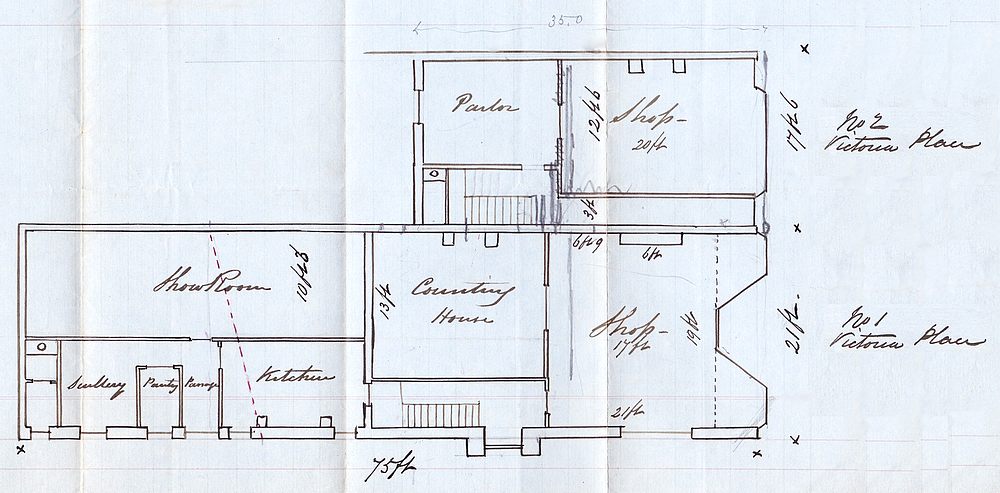
Ground floor plan of 1 & 2 Victoria Place around 1860. The Elms Avenue entrance is at the bottom of the plan.
The ground floor frontage on to Seaside Road was no doubt always intended as a shop and was probably opened as such in 1854. Charles Wille notes in his diary for 11 February 1856 "JBM's family left Lewes for Eastbourne" and this is assumed to be the date when James and his family moved into the accommodation above the Seaside Road shop.
On 9 March 1860 the house next door (No.2 Victoria Place, later to be 67 Seaside Road) became available as part of the sale of all Edward Maynard's properties, and was bought by Morris for £790. No.1 and No.2 were connected by an archway cut in the wall on the second floor. The rate book for 1861 shows E.Morris as owner of 2 Victoria Place but not occupying it (there was still a sitting tenant), and the same applied in 1863.
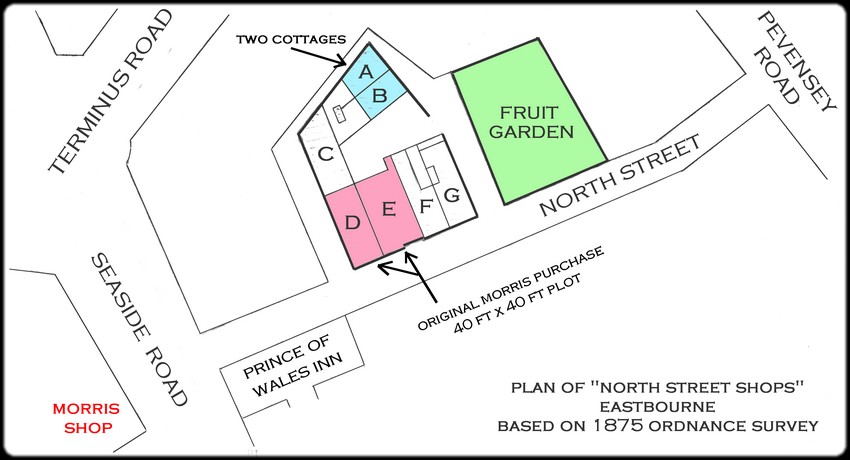
In a plan of projected development dated 1858, the original plots D and E (shown in pink on the map above) were marked respectively as "Workshop" and "Yard". By that time the whole area was Morris property except F (marked "J Maynard") and G (marked "Bradford"). Both F and G were acquired by Morris later. James Berry Morris had already planted trees in the Fruit Garden by 1858, but the two cottages A and B were probably built during the 1860s. George Pettitt, workshop foreman, lived in one of the cottages, and Mr Killick (one of the workers) lived in the other one with his family.
The property built on plot D was a two-floored building recorded as "workshop" on the ground floor and "fitting shop" above. From the beginning, men working at the premises were summoned by a bell, which was greeted by neighbours with a marked lack of enthusiasm, especially as the first period of duty came early in the morning.
(East Sussex Record Office AMS 5569/89/3 to 89/7 is correspondence in 1857 and 1858 regarding complaints from nearby residents about the noise caused by the factory bell.)
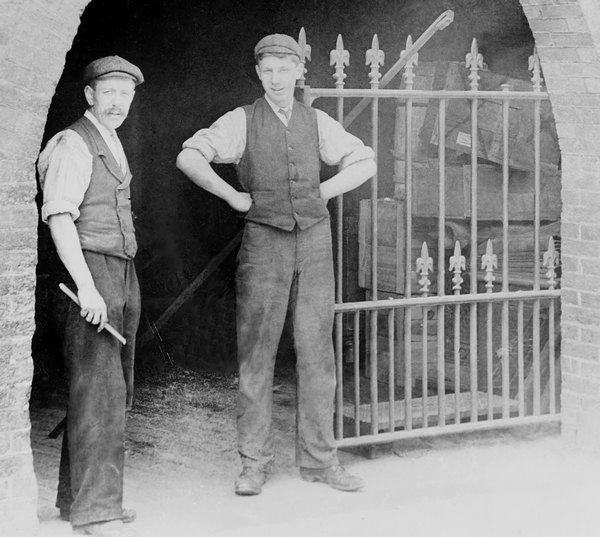
George Pettitt, workshop foreman, at the entrance to the North Street workshop. He lived in one of the cottages behind the works.
On the right is Reginald Nelson Morris (1890-1982), son of Reg Morris (1862-1909).
Probably the biggest contract won by E Morris & Son was the supply of gas lamp standards throughout Eastbourne. The Eastbourne Gas Company was formed in 1852 and their priority was street lighting but, until the end of the century, they only supplied gas and did not provide the standards, so Morris was engaged to make them all. There were over 1,100 lampposts in Eastbourne by the time the system switched to electricity in 1899, and Morris made virtually all of them. All the square-based lanterns were then converted to electric light and later replaced with swan necks.
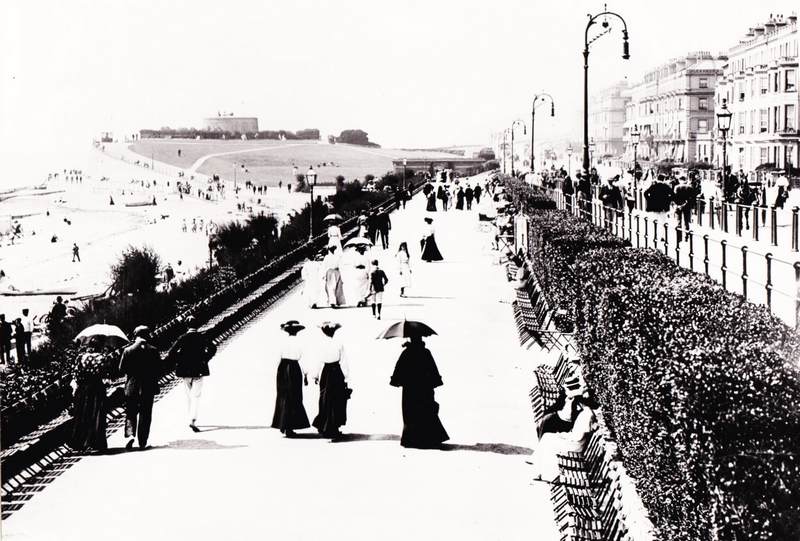
Another view of Eastbourne's Grand Parade, this time around 1900 looking westward.
Three rows of Morris railings are visible, with their incorporated gas lamps (probably converted to electricity by that time).
James Berry Morris, his wife Mary Sophia, and three of their children (Alice, Mary and Robert) moved to "Fernhurst", London Road, Uckfield in June 1899, as a 'semi-retirement'. James's chief interest lay in books and local history (his letters and articles in Sussex papers have much invaluable content) and his increasing activity as a newspaper contributor in the late 1890s suggest a growing detachment from business. His book collection was huge and took some organisation to move to Uckfield on his retirement.
 Details of the move to Uckfield are on this page.
Details of the move to Uckfield are on this page.
So the Morris shop and house in Cliffe High Street, Lewes, was sold in 1890, James Berry Morris retired in 1899 and the Lewes foundry closed in
1900. This just left the Eastbourne shop at 66/67 Seaside Road and the North Street workshops.
Roberts Morris's (Uckfield) diary;
12 August 1901; "Papers relating to the deeds of nos. 66 & 67 in possession of Barclay & Co. arrived to be signed this evening."
13 August 1901; "Miss Markwick witnessed our signatures to Barclay & Co. papers this evening."
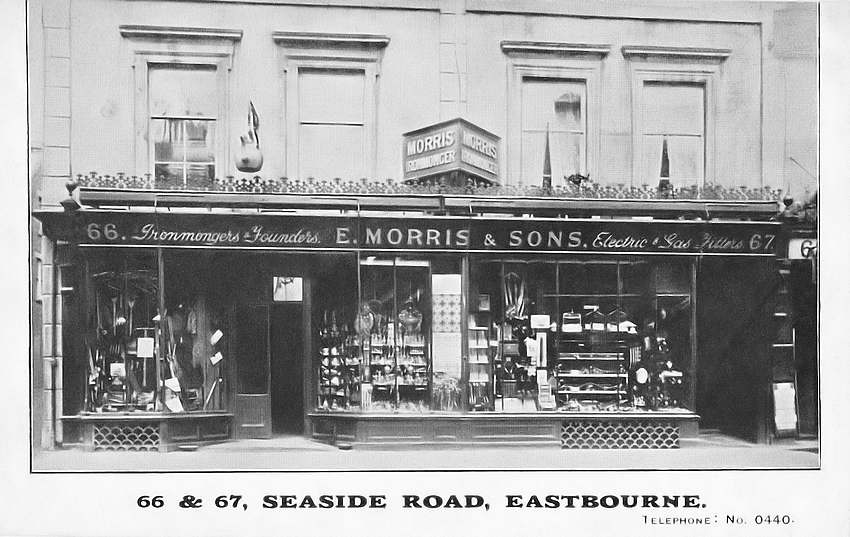
A post card of Morris's shop in Eastbourne. Note the copper kettle hanging outside.
The card was posted in 1906 but the photograph was probably taken several years earlier.
In 1909 May Morris (1892-1985) aged 17, was still using the same picture postcard from the shop (where she was living, as her father Reginald
was running the shop). She wrote apologetically to her cousin Mary Gilbert (1889-1976) in Uckfield "I haven't got a plain Post Card to send".
The major part of Eastbourne's development (particularly along the seafront) had taken place in the 1880s and there was now less of an advantage
for the firm to be on the spot - builders could easily order smaller ironwork requirements from the Midlands.
The "Tinkers Town" workshops in Eastbourne were then taken out of use and made available for lease, but things didn't always go to plan. Robert
Morris's (1865-1948) diary entries record as follows;
21 September 1901; "Received lease for Morris Beef Co. for signing" (It's not known who this firm was.)
22 November 1901; "Signed lease for 14c North Street (Powell's)."
27 November 1901; "James has let the 3rd shop in Tinker's Town to Drury, upholsterer, for £35 per annum."
10 December 1901; "Mother received letter from James. C F Simmons has taken the stables at £55. Powell has bolted, and Drury has decided not
to take his shop."
13 December 1901; "Signed paper permitting Morris Beef Co. to sub-let top floor."
H.R.Gilbert has a letter dated 19 December 1901 from James Morris at 66/67 Seaside Road (the Morris shop in Eastbourne) to Ellen Gilbert (his sister) at "Seaside Buildings", Eastbourne (Gilbert's Bakery), in which he lists the valuations he has just received for 14b, 14c, 14d, 14e North Street and the stables, although it is not known which buildings they were, or how the numbers relate to the letters on the map above.
Robert Morris's (Uckfield) diary records;
27 December 1901; "Frank arrived at 10 a.m. & James, Ellen, Reg & Harry at 1 p.m. We had the family meeting this afternoon. 14b North Street
bought by Frank £420. 14c by me £525. 14d by Mrs.D.Gilbert £525. 14e by Mary £600. Stables by Alice £825."
7 January 1902; "C.F.Simmons has taken possession of Alice's stables, he went in yesterday."
So the owners and occupants in North Street from 1901 onwards were;
14b; (Frank) Occupant not known. Maybe none.
14c; (Robert) Powell (later 'bolted'). To Hamblyn in 1908.
14d; (Mrs.Ellen I Gilbert) Drury, upholsterer (apparently did not actually occupy). Ground floor taken by Clayton in 1907. In the schedule of
Ellen I.Gilbert's estate drawn up in 1953 (after her death in 1951) she appears still to have held the freehold of 14d North Street
14e; (Mary) Morris Beef Company. Left in 1904, returned in 1917 for 3 years.
Stables; (Alice) C.F.Simmons.
James's old Fruit Garden in North Street was sold off and developed; a block of four small shops with offices above was built on the site, and it is still there, now converted to small apartments as "Compass Court". At the same time James's sons Henry and Reginald came to live at 66/67 Seaside Road with their families while James (junior) continued to live at 15 Gorringe Road. 66/67 Seaside Road was later renumbered 21 Seaside Road, and then (by 1974) 11 Seaside Road.
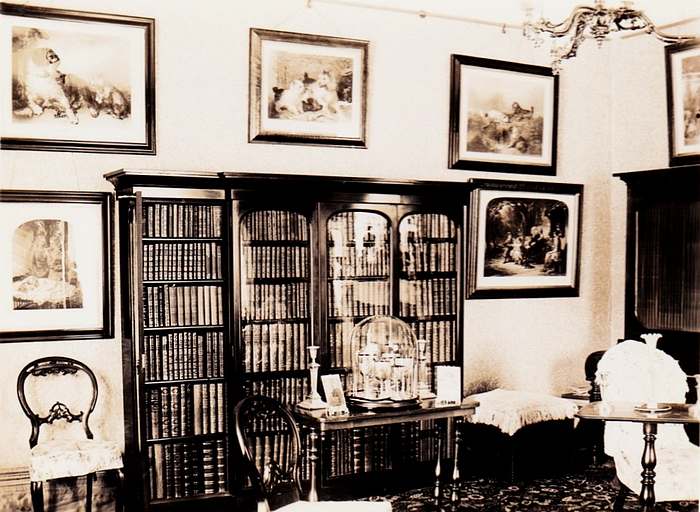
The drawing room at 66 Seaside Road around 1890. The large bookcase (which probably came from the Lewes house, and contained part of James's
huge book collection) passed to the Gilbert family in Eastbourne, finally being sold in 1987.
Robert Morris's (Uckfield) diary records;
8 April 1902; "Mrs.Simms, the wife of the porter at E.M.& S. died on Sunday last (6th inst.). Her heart went wrong and dropsy set in."
20 June 1902; "Received our cheques & received deeds of North St. property and promissary notes. I opened an account at Barclays Bank
today £213.12.10."
5 July 1902; "Alice opened her account with Messrs. Barclay & Co. this morning. She received her first ?? sent from Mr.C.F.Simmons for her
stables."
1 February 1904; "We understand that the Morris Beef Co. has cleared out of Mary's shop in North St."
29 March 1904; "We hear that Simms, the porter of E.M.& S., has been expelled for stealing."
4 May 1907; "Clayton has agreed to take Mrs.Gilbert's ground floor in North street."
15 July 1907; "'Chub' is at present attending at the shop, Nos. 66 & 67 for his keep." ('Chub' was Herbert Morris)
2 January 1908; "To Eastbourne by 10.36 am train, returned at 10 pm. Saw Clayton about lease of 14c North St."
31 January 1908; "Received lease - 14c North Street - from Mr.Hamblyn, and sent it off again this evening."
12 February 1908; "Counterpart of lease - 14c North St. - to hand. Settled with Mr. Hamblyn (10/6)."
4 November 1908; "Old Jimmy Winder of Clifton House School has failed for some thousands. E.M.& S. lose about £75."
19 June 1909; "They are stocktaking at E.M.& S.'s and find it to be a big job."
23 June 1909; "They are getting on with the stocktaking."
9 July 1909; "Received document from Vinall's to be signed, giving extension of ?? to E.M.& S."
14 September 1909; "David
21 July 1910; "James arrived this afternoon and left again at 8 pm. C.F.Simmons wants to hire, or buy, the workshops in North St."
28 July 1911; "It appears Bobby & Co., the drapers, is likely to make an offer for our property in North St., and Frank is very anxious to sell."
31 October 1911; "Received letter from James informing me they had sold the premises at Nos.66 & 67 Seaside Road."
5 January 1912; "Wrote Messrs.Vinall about stocktaking at E.M.& S.'s."
12 January 1912; "Herbert has started work at E.M.& S.'s; it is a funny thing, but he has got there again, after all the talk about the poor
old business."
28 March 1912; "Mrs.Gilbert told me of a rather serious turn in the affairs of Messrs. E.M.& S. T.H.J. has been embezzling, and there is a
likelihood of bankruptcy as well."
23 October 1913; "Mary thinks of buying Frank's workshop in North St. £530 is asked for it, but it is not worth £350."
4 November 1913; "Mary to Bexhill and Eastbourne to see about purchasing Frank's workshop, & house at Bexhill."
9 January 1914; "The Morris Beef Coy. take on M.S.M.'s shop in North Street for 3 years."
14 March 1914; "Mrs.Killick of North Street, Eastbourne, died just after 9 am today."
2 December 1914; "'Jimmy' Killick died on Monday night (30th inst.) - the last of the old workmen of E.M.& S. to go."
30 December 1914; "Mrs.J.B.M. received a letter from George Killick."
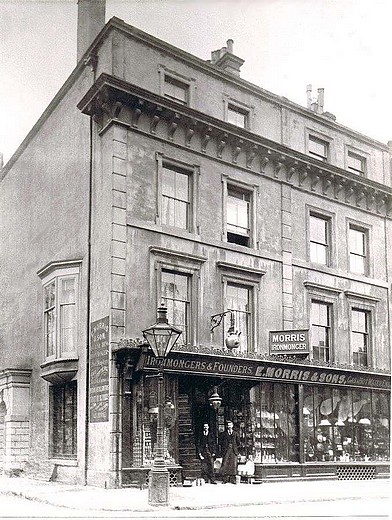
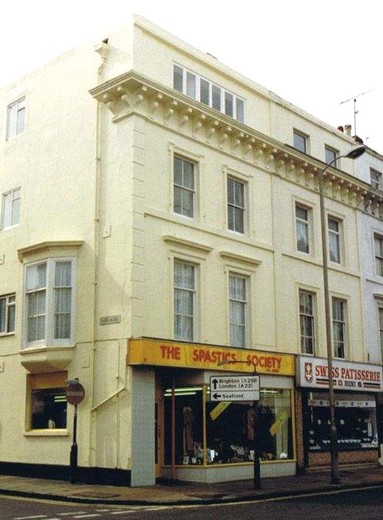
The Morris shop in Seaside Road, Eastbourne photographed in 1899 and by H R Gilbert on 27 March 1994.
In the early (left-hand) picture shopkeeper Reginald Morris (1862-1909) is standing in the doorway under the copper kettle.
The gas lamp post outside is, of course, a Morris product.
Partner James Morris (junior) had died in 1909 and brother Reginald also died in 1921, leaving just Henry. Business was not going well and the North Street workshop was sold in 1925, with the repair department moving to the cellars of the Seaside Road shop, and on 14 November of that year the shop itself finally closed.
According to Arthur Wellesley Morris (1903-1982) in 1974, his father Henry "...carried on the works department at 14b North Street (over the wholesale butcher's shop). About 18 December 1925 he took over Mr King's shop (bootmaker) lower down the road (Uncle Frank's old shop) for showroom and office. Eventually he took over the whole shop and left 14b. It was at this time that George Pettitt (foreman) came into partnership."
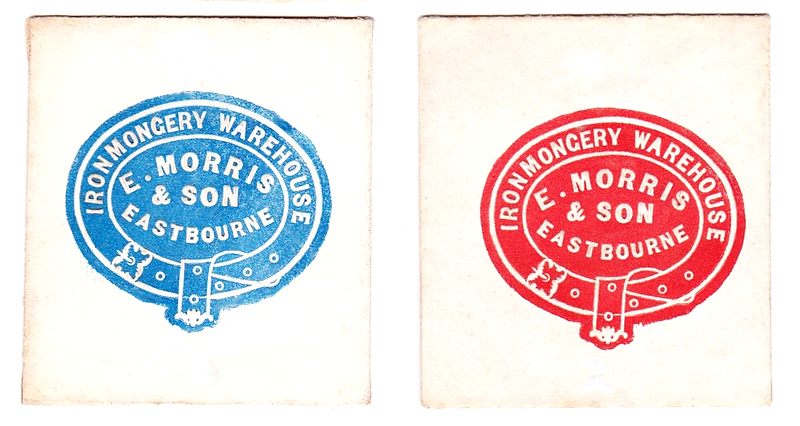
Morris wage packets, roughly actual size. They also came in green and brown.
As Arthur said, the business was transferred to one of the smaller shops in North Street, along with the famous copper kettle. When Henry Morris retired from the business on 30 June 1933, aged 70, he represented the last of the Morrises to be connected with the firm, and it was continued by George Pettitt, formerly the foreman and with whom Henry had entered into partnership. The Pettitt family lived in one of the cottages behind the works, later moving to 49 & 51 Langney Road, Eastbourne, and were believed to be still there in the 1970s.
In about 1936 the business moved to 22 Pevensey Road, Eastbourne, being run latterly by George Pettitt's son Harry, specialising in fishing tackle, but seems to have closed down completely around 1954. The copper kettle disappeared without trace. Alice Morris (who moved to Canada when her father Frank Morris <1869-1965)> emigrated with his family in 1913) wrote to Richard Gilbert in April 1966 "I cannot understand the man destroying the kettle, because my sister Rhoda when in England in 1948 attempted to buy it to bring it to Canada, and the owner flatly refused to sell it. He said it went with the business."

To commemorate European Architectural Year in 1975, four Victorian E Morris & Son lamp standards and lanterns were erected in Trinity Trees, Eastbourne, following a successful appeal for funds by the Eastbourne Civic Society. At a ceremony on 18 September 1976 a plaque affixed to one of the posts was unveiled by Ebenezer Morris's great-grandson Reginald Morris. Six other great-grandchildren were present, including Arthur Morris, Catherine 'Katie' Morris, Marjorie Morris, Richard Gilbert, Ellen Gilbert and Mrs May Vinall. A great-great-granddaughter, Miss Jane Morris, also attended.

East Sussex Record Office AMS 5569/69/149 is a trade card calendar of E.Morris & Son, 66 Seaside Road, dated 1887.
